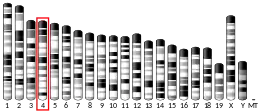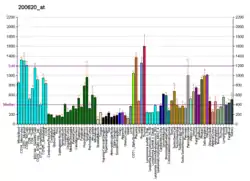TMEM59
Transmembrane protein 59 is a protein that in humans is encoded by the TMEM59 gene.[5][6]
| TMEM59 | |||||||||||||||||||||||||||||||||||||||||||||||||||
|---|---|---|---|---|---|---|---|---|---|---|---|---|---|---|---|---|---|---|---|---|---|---|---|---|---|---|---|---|---|---|---|---|---|---|---|---|---|---|---|---|---|---|---|---|---|---|---|---|---|---|---|
| Identifiers | |||||||||||||||||||||||||||||||||||||||||||||||||||
| Aliases | TMEM59, C1orf8, HSPC001, DCF1, PRO195, UNQ169, transmembrane protein 59 | ||||||||||||||||||||||||||||||||||||||||||||||||||
| External IDs | OMIM: 617084 MGI: 1929278 HomoloGene: 3583 GeneCards: TMEM59 | ||||||||||||||||||||||||||||||||||||||||||||||||||
| |||||||||||||||||||||||||||||||||||||||||||||||||||
| |||||||||||||||||||||||||||||||||||||||||||||||||||
| |||||||||||||||||||||||||||||||||||||||||||||||||||
| |||||||||||||||||||||||||||||||||||||||||||||||||||
| |||||||||||||||||||||||||||||||||||||||||||||||||||
| Wikidata | |||||||||||||||||||||||||||||||||||||||||||||||||||
| |||||||||||||||||||||||||||||||||||||||||||||||||||
TMEM59 is a membrane bound protein that is localized to the Golgi apparatus.[7] The precise function of TMEM59 is not known, however it has been demonstrated that expression of TMEM59 protein inhibits Golgi glycosylation of amyloid precursor protein (APP) and blocks APP cleavage by the α- and β-amyloid precursor protein secretases and therefore inhibits formation of the beta amyloid peptide that forms amyloid plaques in Alzheimer's disease.[7] Moreover, TMEM59 has been shown to potentiate wnt signaling by promoting formation of the wnt receptor signalosomes. Transmembrane interactions between TMEM59 and the wnt receptor Frizzled were found to drive receptor multimerization that leads to improved potency and efficacy of wnt signaling.[8]
References
- GRCh38: Ensembl release 89: ENSG00000116209 - Ensembl, May 2017
- GRCm38: Ensembl release 89: ENSMUSG00000028618 - Ensembl, May 2017
- "Human PubMed Reference:". National Center for Biotechnology Information, U.S. National Library of Medicine.
- "Mouse PubMed Reference:". National Center for Biotechnology Information, U.S. National Library of Medicine.
- Mao M, Fu G, Wu JS, Zhang QH, Zhou J, Kan LX, Huang QH, He KL, Gu BW, Han ZG, Shen Y, Gu J, Yu YP, Xu SH, Wang YX, Chen SJ, Chen Z (July 1998). "Identification of genes expressed in human CD34(+) hematopoietic stem/progenitor cells by expressed sequence tags and efficient full-length cDNA cloning". Proceedings of the National Academy of Sciences of the United States of America. 95 (14): 8175–80. Bibcode:1998PNAS...95.8175M. doi:10.1073/pnas.95.14.8175. PMC 20949. PMID 9653160.
- "Entrez Gene: TMEM59 transmembrane protein 59".
- Ullrich S, Münch A, Neumann S, Kremmer E, Tatzelt J, Lichtenthaler SF (July 2010). "The novel membrane protein TMEM59 modulates complex glycosylation, cell surface expression, and secretion of the amyloid precursor protein". The Journal of Biological Chemistry. 285 (27): 20664–74. doi:10.1074/jbc.M109.055608. PMC 2898310. PMID 20427278.
- Gerlach JP, Jordens I, Tauriello DV, van 't Land-Kuper I, Bugter JM, Noordstra I, van der Kooij J, Low TY, Pimentel-Muiños FX, Xanthakis D, Fenderico N, Rabouille C, Heck AJ, Egan DA, Maurice MM (April 2018). "TMEM59 potentiates Wnt signaling by promoting signalosome formation". Proceedings of the National Academy of Sciences of the United States of America. 115 (17): E3996–E4005. Bibcode:2018PNAS..115E3996G. doi:10.1073/pnas.1721321115. PMC 5924918. PMID 29632210.
Further reading
- Maruyama K, Sugano S (January 1994). "Oligo-capping: a simple method to replace the cap structure of eukaryotic mRNAs with oligoribonucleotides". Gene. 138 (1–2): 171–4. doi:10.1016/0378-1119(94)90802-8. PMID 8125298.
- Suzuki Y, Yoshitomo-Nakagawa K, Maruyama K, Suyama A, Sugano S (October 1997). "Construction and characterization of a full length-enriched and a 5'-end-enriched cDNA library". Gene. 200 (1–2): 149–56. doi:10.1016/S0378-1119(97)00411-3. PMID 9373149.
- Zhang QH, Ye M, Wu XY, Ren SX, Zhao M, Zhao CJ, Fu G, Shen Y, Fan HY, Lu G, Zhong M, Xu XR, Han ZG, Zhang JW, Tao J, Huang QH, Zhou J, Hu GX, Gu J, Chen SJ, Chen Z (October 2000). "Cloning and functional analysis of cDNAs with open reading frames for 300 previously undefined genes expressed in CD34+ hematopoietic stem/progenitor cells". Genome Research. 10 (10): 1546–60. doi:10.1101/gr.140200. PMC 310934. PMID 11042152.
- Clark HF, Gurney AL, Abaya E, Baker K, Baldwin D, Brush J, Chen J, Chow B, Chui C, Crowley C, Currell B, Deuel B, Dowd P, Eaton D, Foster J, Grimaldi C, Gu Q, Hass PE, Heldens S, Huang A, Kim HS, Klimowski L, Jin Y, Johnson S, Lee J, Lewis L, Liao D, Mark M, Robbie E, Sanchez C, Schoenfeld J, Seshagiri S, Simmons L, Singh J, Smith V, Stinson J, Vagts A, Vandlen R, Watanabe C, Wieand D, Woods K, Xie MH, Yansura D, Yi S, Yu G, Yuan J, Zhang M, Zhang Z, Goddard A, Wood WI, Godowski P, Gray A (October 2003). "The secreted protein discovery initiative (SPDI), a large-scale effort to identify novel human secreted and transmembrane proteins: a bioinformatics assessment". Genome Research. 13 (10): 2265–70. doi:10.1101/gr.1293003. PMC 403697. PMID 12975309.
- Otsuki T, Ota T, Nishikawa T, Hayashi K, Suzuki Y, Yamamoto J, Wakamatsu A, Kimura K, Sakamoto K, Hatano N, Kawai Y, Ishii S, Saito K, Kojima S, Sugiyama T, Ono T, Okano K, Yoshikawa Y, Aotsuka S, Sasaki N, Hattori A, Okumura K, Nagai K, Sugano S, Isogai T (2007). "Signal sequence and keyword trap in silico for selection of full-length human cDNAs encoding secretion or membrane proteins from oligo-capped cDNA libraries". DNA Research. 12 (2): 117–26. doi:10.1093/dnares/12.2.117. PMID 16303743.




